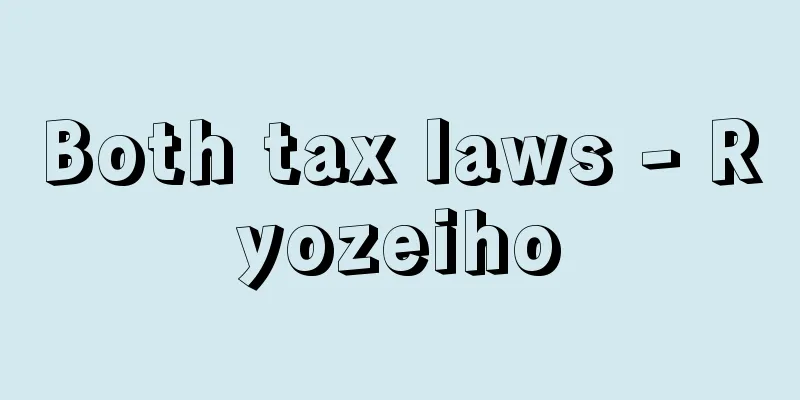Both tax laws - Ryozeiho

|
This was a tax law that was in place from the Tang to Ming dynasties in China. As early as the mid-8th century, household taxes, wheat taxes, and other taxes were already collected in both summer and autumn as summer and autumn taxes, and were known as the "two taxes." In 780, this was systematized as the Two Tax Law proposed by Yang Yan (727-81), which emerged as a major reform in the history of Chinese taxation. In the 8th century, the rule of the Tang dynasty's Ritsuryo system was shaken, and the tax and labor tax system, which was based on equal payments in kind to each person, collapsed, eventually collapsing completely during the An Lushan Rebellion. Due to financial constraints, the amount of the existing household tax was increased and a variety of new taxes were introduced, such as the imposition of green seedling and land steward taxes on cultivated land, but cunning landlords and wealthy merchants attempted to evade taxes, bureaucrats lined their pockets, feudal governors refused to pay taxes, small and medium-sized farmers fell into poverty and fled, and it was impossible to expect any secure revenue. The two tax laws responded to this reality, and their main contents are as follows: (1) Each village or village will be responsible for the tax burden of its current residence. (2) Each household's assets will be divided into nine categories, and actual coins (copper coins) will be collected according to the amount (corresponding to the previous household tax). (3) Products such as wheat, foxtail millet, and rice will be collected according to the area of cultivated land owned (corresponding to the rice field tax). (4) Taxes will be collected in both summer and autumn. Summer tax (products such as summer wheat, silk and cotton) will be paid by June, and autumn tax (products such as foxtail millet, rice, some silk and cotton) will be paid by November. (5) Merchants will be taxed one-thirtieth of their sales in their place of residence. (6) Assets will be evaluated every three years. At that time, summer wheat cultivation was widespread in North China, rice cultivation was progressing in Jiangnan, and sericulture was also flourishing, so the summer and autumn tax system was suited to this, and it was simplified to twice a year, and had the advantage of being able to calculate expenditures and create budgets in principle, and it formed the basis of China's tax system until the establishment of the Yi-tianwen Law in the Ming Dynasty. However, in addition to the two taxes, the green miao coins remained, and sometimes cloth, millet, wheat, etc. were priced low and people were forced to pay the two taxes in lieu, and other monopoly taxes were increased on salt, tea, etc., causing hardship to the people. On the other hand, taxation according to the amount of assets and cultivated land was, so to speak, an official recognition of private land ownership, and the collection of the two taxes, the green miao coins, and the monopoly policies for salt, tea, etc. spread the monetary economy even to rural areas, the gap between rich and poor widened, large land ownership developed, and a new class of landlords emerged. In this way, the aristocratic and bureaucratic society of the Tang Dynasty collapsed. [Shuichi Matsui] "The Establishment and Development of the Ryōtei Law by Matsui Shuichi (included in Iwanami Lectures on World History 6: Ancient Times 6, 1971, Iwanami Shoten) " "Funakoshi Taiji, "The Issue of the Collection of Taxes by Hokudō and the Filing and Payment of Ryōtei Coins under the Ryōtei Law of the Tang Dynasty: In Relation to the Taxation System of the Ryōtei Law" (included in Oriental History Studies, Vol. 31, No. 4, 1973, Oriental History Research Association)" Source: Shogakukan Encyclopedia Nipponica About Encyclopedia Nipponica Information | Legend |
|
中国の唐代から明(みん)代にかけて行われた税法。8世紀の中ごろ、すでに戸税銭や麦税などを夏税、秋税として、夏秋両期に徴収し、両税と称していた。780年にこれを体系化し、中国税制史上の一大改革として登場したのが、楊炎(ようえん)(727―81)の建議による両税法である。8世紀には唐の律令制支配は動揺し、対人均等現物主義の租庸調制は崩れ、安史の乱でまったく破綻(はたん)した。財政の逼迫(ひっぱく)は、従来の戸税の銭額を引き上げ、耕地に青苗銭、地頭銭を課するなど雑多な新税を設けたが、狡猾(こうかつ)な地主や富商は脱税を謀り、官僚は私腹を肥やし、藩鎮は輸税を拒み、中小の農民は没落、流亡し、歳入の確保は期待しえなかった。 両税法はこの現実に対応するもので、そのおもな内容は以下のとおりである。(1)各郷村はその現住戸を税役負担者とする。(2)各戸の資産を九等に分け、それに応じて現銭(銅銭)を徴収(従来の戸税に相当)。(3)所有耕地面積に応じてムギ、アワ、イネなどの生産物を徴収(田租に相当)。(4)夏秋両期に徴収。夏税(生産物としては夏ムギ、絹綿(まわた)など)は6月まで、秋税(同じくアワ、イネ、一部の絹綿など)は11月まで納入。(5)商人からはその居住地で売上高の30分の1を徴収。(6)資産の評価は3年ごとに行う。 当時、華北では夏ムギの耕作が普及し、江南では稲作が進展し、養蚕も盛んになって、夏秋両期徴収はこれに適合し、かつ年2回徴収と単純化し、原則として歳出を計って予算をたてるなどの優れた点があり、明代に一条鞭法(いちじょうべんぽう)が成立するまで、中国税制の根幹をなした。しかし、両税のほか青苗銭は残存し、ときに布帛(ふはく)、アワ、ムギなどを安価に見積もって両税銭の代納を強制し、そのほか、塩、茶などの専売税を増大させて民衆を苦しめた。他方、資産や耕地の多少に応じて課税したことは、いわば土地私有を公認したことであり、両税銭、青苗銭の徴収、塩、茶などの専売策は、農村にまで貨幣経済を浸透させ、貧富の差はいよいよ拡大し、大土地所有制が展開し新興地主層が台頭してきた。こうして唐の貴族官僚社会は崩れ去るのである。 [松井秀一] 『松井秀一著『両税法の成立とその展開』(『岩波講座 世界歴史6 古代6』所収・1971・岩波書店)』▽『船越泰次「唐代両税法における斛斗の徴科と両税銭の折糴・折納問題――両税法の課税体系に関連して」(『東洋史研究』31巻4号所収・1973・東洋史研究会)』 出典 小学館 日本大百科全書(ニッポニカ)日本大百科全書(ニッポニカ)について 情報 | 凡例 |
<<: Amphibians - ryoseirui (English spelling) amphibian
>>: Liaoxi Province - Liaoxi Province (English spelling)
Recommend
《Zeitschrift für die geschichtliche Rechtswissenschaft》 (English notation) ZeitschriftfurdiegeschichtlicheRechtswissenschaft
…He was at the center of academic and political l...
Kalhu
... In the first millennium BC, successive kings ...
Cao Cao - That's right
Founder of the Three Kingdoms Wei Dynasty in Chin...
Dubai (English spelling)
Also spelled Dubai. One of the emirates that make ...
Ryukan
A monk of the Heian and Kamakura periods. One of ...
Galago demidovii (English spelling) Galago demidovii
…[Yukio Takahata]. … *Some of the terminology tha...
Menger - Menger (English spelling) Carl Menger
Austrian economist and founder of the Austrian Sc...
Anori Puppet Show - Anori Puppet Show
...The entire town is a scenic spot that is part ...
Summary calculation method
A book on Japanese mathematics. Published in 1712 ...
Conditioned reflex
A conditioned reflex is a reflex acquired later i...
Buhen
… [Yasuo Takahashi] [Western] Moats surrounding c...
Sarema
…An island in the western part of the Republic of...
Polar vortex
A low pressure system that exists in the middle to...
Shakubuku -
A method of teaching in Buddhism. The opposite of...
Kiselyov's reforms
...In 1816, he submitted a memorandum to the Tsar...









